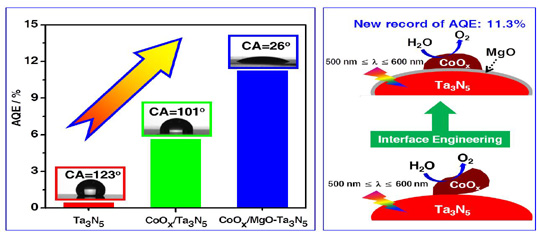Recently, an important progress in photocatalytic water splitting with wide visible-light-responsive semiconductor was made by Prof. Can Li and Prof. Fuxiang Zhang, et al. from SKLC, DNL. It was reported that a MgO nanolayer was introduced as an interfacial modifier between the semiconductor Ta3N5 (Eg: 2.1 eV, with an absorption edge of 600 nm) and the cocatalyst CoOx, which not only improved the interfacial contact and the dispersion of CoOx nanoparticles, but also passivated the surface of Ta3N5. This developed photocatalytic system is very efficient in water oxidation reaction,with an apparent quantum efficiency (AQE) of 11.3% at 500−600 nm, which is two times that of the state-of-the-art Ta3N5 photocatalyst (5.2%). This work has been recently published in the journal of Angewandte Chemie International Edition
(http://onlinelibrary.wiley.com/doi/10.1002/anie.201409906/abstract).

Solar-driven water splitting for hydrogen production is an important reaction in solar-to-chemical energy conversion, which is considered as a “Holy Grail” of chemistry. The photocatalytic water splitting reaction involves two half reactions of proton reduction and water oxidation, in which the water oxidation reaction is regarded as the rate-determining step, due to it is an non spontaneous process and contains the multi-electrons transfer. One of the key issues in the field of photocatalytic water splitting is to utilize solar spectra as widely as possible. However, with the increase of the absorption edge of the semiconductor, the driving force for the charge transfer and redox reactions correspondingly decreases. Therefore, it is still challenging to simultaneously realize the wide visible light utilization and efficient charge separation, especially for the water oxidation reaction.
Prof.Can Li’s group has been devoting to the development of cocatalyst, whose function is known to boost the photogenerated charges separation and the catalytic conversion, and some breakthroughs, such as the strategy of dual cocatalysts, have been achieved and summarized recently (Acc.Chem. Res. 2013, 46, 2355). In order to conquer the problem of highly efficient water oxidation on the wide visible-light-responsive photocatalyts,they have developed a loading strategy of low-cost cocatalyst CoOx, and achieved a much better water oxidation performance on the semiconductor of LaTiO2N (Eg: 2.1eV) than that with the noble metal cocatalyst of IrO2 or RuO2 (J. Am. Chem. Soc. 2012, 134, 8348-8351.). In addition, this strategy has also been extended to the newly developed wide visible-light-responsive nitrogen-dopedoxides of Sr5Ta4O15-xNx and MgTa2O6−xNx (J. Mater. Chem. 2013, 12, 5651; Chem.Commun. 2014, 50, 14415).
In this work, a MgO nanolayer was introduced to mediate the interfacial compatibility of CoOx/Ta3N5 photocatalyst, leading to an improved dispersion of CoOx nanoparticles and an efficient interfacial charge transfer. Based on this, they fabricated the highest efficient photocatalytic water oxidation system ever reported, with an AQE of 11.3% at the wavelength of 500−600 nm. The interface engineering is expected to be a promising strategy for other photocatalytic systems to achieve an enhanced solar energy conversion efficiency.
This work is financially supportedby National Natural Science Foundation of China, the Basic Research Program of China (973 project) and the “Hundred Talents Program” of Chinese Academy of Sciences. (by Fuxiang Zhang and Shanshan Chen)



